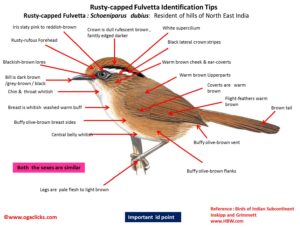
Rusty-capped Fulvetta Schoeniparus dubius
Etymology:
- Schoeniparus : latin word schoenus –rush, reed; parus-tit
- Dubius: Latin word for Doubtful, dubious
- Mandellii: Luigi Hildebrando Mandelli (1832-1880) Italian tea planter in Darjeeling
Distribution in India: Resident of Hills of North East India.
Race: S. d. mandellii – Bhutan, North East Indian hill states
Description: Size 14–15 cm; 14–22 g. It is a smallish fulvetta, brown above and buffy below, with rusty-rufous forehead and bold black and white lines on crown side. Nominate race has rusty-rufous forehead, shading to dull rufescent brown on crown and nape, feathers faintly edged darker, long black lateral crownstripe and white supercilium starting above eye and running back onto nape. The upperparts, upperwing and tail are warm brown; lores blackish-brown, ear-coverts warm brown. The throat is whitish, tinged warm buff at side and on submoustachial area, breast washed warm buff, central belly whitish, flanks and undertail-coverts buffy olive-brown. The iris is slaty pink to reddish-brown; bill is dark brown or grey-brown to black; legs are pale flesh to light brown. Both the sexes are similar.
Race mandellii is distinctive, with stronger scaling on crown, blackish ear-coverts, extensive contrasting pointed buff and dark streaks behind ear-coverts, and lores and area under eye black.
Habitat: It is found in broadleaf forest, dense bushes, bracken, brambles and grassy undergrowth in light forest or forest edge, overgrown clearings, bamboo, scrub and secondary growth, bushy undergrowth and grass in pine forest. It is found at 900–2400 m in India.
Food habits: It eats insects, beetles and grass seeds. It is found in small parties outside breeding season, associating rarely with other species. It forages in dense undergrowth on or near ground, sometimes ascending to lower parts of tree trunks.
Breeding habits: They breed in Apr–Jun in India. The nest is built by both sexes. The nest is a loose oval or dome-shaped structure, with entrance towards top, made of bamboo or other dead leaves, grasses, fern, stalks and roots, lined with rootlets and fibres, placed on ground among dead leaves or sheltered by grass tuft, fern or ginger plant, or among creepers over rock, above ground. They lay a clutch of 2–5 eggs. The eggs are white to creamy or clay-white with blackish-brown spots, specks and hair-lines, clouded with yellowish-brown or pale reddish-brown and with faint inky-purple or grey spots and blotches. Incubation by both sexes.